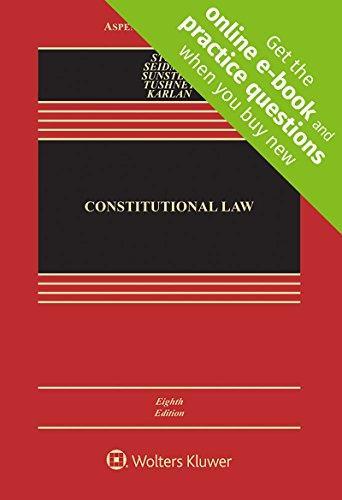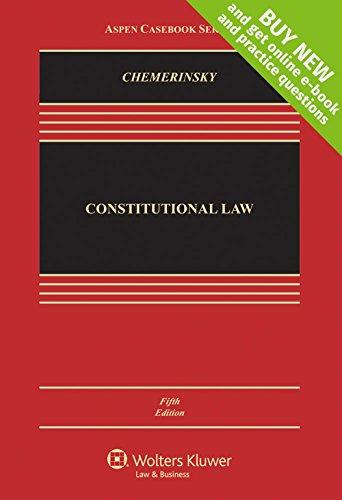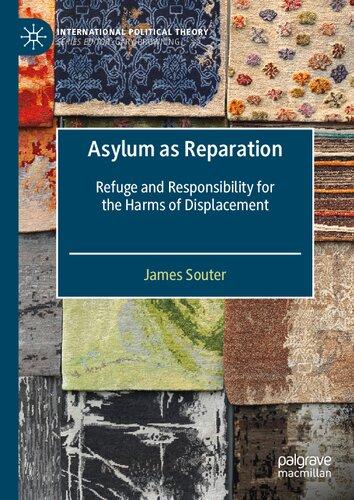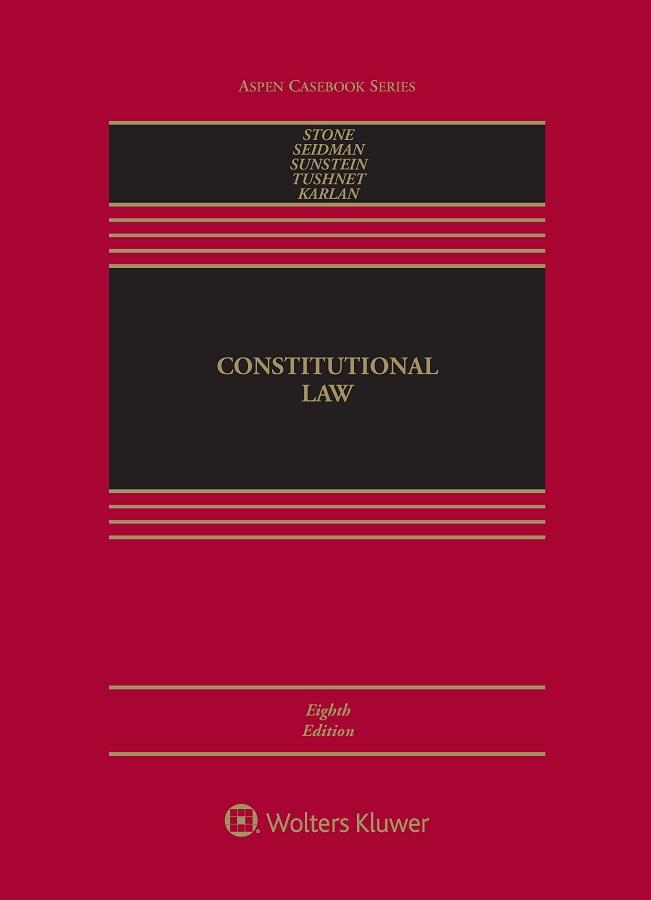About Wolters Kluwer Legal & Regulatory U.S.
Wolters Kluwer Legal & Regulatory U.S. delivers expert content and solutions in the areas of law, corporate compliance, health compliance, reimbursement, and legal education. Its practical solutions help customers successfully navigate the demands of a changing environment to drive their daily activities, enhance decision quality and inspire confident outcomes.
Serving customers worldwide, its legal and regulatory portfolio includes products under the Aspen Publishers, CCH Incorporated, Kluwer Law International, ftwilliam.com and MediRegs names. They are regarded as exceptional and trusted resources for general legal and practice-specific knowledge, compliance and risk management, dynamic workflow solutions, and expert commentary.
For our families
Summary of Contents
Contents
Preface to the Eighth Edition
Acknowledgments
Editorial Notice
The Constitution of the United States
Biographical Notes on Selected U.S. Supreme Court Justices
The Supreme Court since 1789
I
The Constitution and the Supreme Court
A. The Origins of The U.S. Constitution
B. The Basic Framework
C. The Sources of Judicial Decisions: Text, Original Meaning, Structure, Morality
D. Political Control over the Supreme Court
E. “Case or Controversy” Requirements and the Passive Virtues
F. The Jurisdiction of the Supreme Court
II
Federalism at Work: Congress and the National Economy
A. The Values of Federalism and Some Techniques for Implementing Them
B. Doctrinal Fundamentals: Federalism and Judicial Review
C. The Evolution of Commerce Clause Doctrine: The Lessons(?) of History
D. State Regulation of Interstate Commerce
E. Preemption
III
The Scope of Congress’s Powers: Taxing and Spending, War Powers, Individual Rights, and State Autonomy
A. Regulation through Taxing, Spending, and the War Power
B. Congress’s Enforcement Power under the Reconstruction Amendments
C. The Treaty Power
D. The Tenth Amendment as a Federalism-Based Limitation on Congressional Power
IV
The Distribution of National Powers
A. Introduction
B. Case Study: Presidential Seizure
C. Foreign Affairs
D. Domestic Affairs
V
Equality and the Constitution
A. Slavery, Jim Crow, and the Equal Protection Principle
B. Equal Protection Methodology: Rational Basis Review
C. Equal Protection Methodology: Heightened Scrutiny and the Problem of Race
D. Equal Protection Methodology: Heightened Scrutiny and the Problem of Gender
E. Equal Protection Methodology: The Problem of Sexual Orientation
F. Equal Protection Methodology: Other Candidates for Heightened
Scrutiny
VI
Implied Fundamental Rights
A. Introduction
B. The Privileges or Immunities Clause
C. The Due Process Clause and the Incorporation Controversy
D. Substantive Due Process: The Protection of Economic Interests and the Question of Redistribution
E. Fundamental Interests and the Equal Protection Clause
F. Modern Substantive Due Process: Privacy, Personhood, and Family
G. Procedural Due Process
H. The Contracts and Takings Clauses
VII
Freedom of Expression
A. Introduction
B. Content-Based Restrictions: Dangerous Ideas and Information
C. Overbreadth, Vagueness, and Prior Restraint
D. Content-Based Restrictions: “Low” Value
E. Content-Neutral Restrictions: Limitations on the Means of Communication and the Problem of Content-Neutrality
F. Freedom of the Press
VIII
The Constitution and Religion
A. Introduction: Historical and Analytical Overview
B. The Establishment Clause
C. The Free Exercise Clause: Required Accommodations
D. Permissible Accommodation
E. Free Exercise, Free Speech, and the Right of Expressive Association
IX
State Action
A. State Action, Federalism, and Individual Autonomy
B. Pure Inaction and the Theory of Governmental Neutrality
C. Constitutionally Impermissible Departures from Neutrality: State Subsidization, Approval, and Encouragement
D. Constitutionally Required Departures from Neutrality: The Public Function Doctrine
E. Unconstitutional Conditions and the Benefit/Burden Distinction
F. Some Final Thoughts
Table of Cases
Table of Authorities
Index
Contents
Preface to the Eighth Edition
Acknowledgments
Editorial Notice
The Constitution of the United States
Biographical Notes on Selected U.S. Supreme Court Justices
The Supreme Court since 1789
IThe Constitution and the Supreme Court
A. The Origins of the U.S. Constitution
The Federalist No. 10 (Madison)
Note: Madisonian Republicanism
The Federalist No. 51 (Madison)
Note: Madisonian Republicanism and Checks and Balances
Note: Madisonian Republicanism and Contemporary
Constitutionalism
Note: Why (and How) Does the Constitution Bind?
B. The Basic Framework
Marbury v. Madison
Note: Marbury v. Madison
Martin v. Hunter’s Lessee
Note: Supreme Court Review of State Courts and State Laws
Note: Judicial Exclusivity in Constitutional Interpretation?
C. The Sources of Judicial Decisions: Text, Original Meaning, Structure, Morality
1. Text and Original Meaning
District of Columbia v. Heller
Note: Text and “Original Public Meaning”
2. Structure
McCulloch v. Maryland
Note: Constitutional Methodology and Interpretation in McCulloch
3. Natural Law and Natural Rights
Calder v. Bull
Note: Natural Law, Moral Argument, and the Supreme Court
D. Political Control over the Supreme Court
Note: Amendment, Appointment, Impeachment, and the Election Returns
Ex parte McCardle
Note: Political Control over Jurisdiction of Article III Courts
Note: The Power of Reprisal General Thoughts
E. “Case or Controversy” Requirements and the Passive Virtues
1. Advisory Opinions
2. Standing
Lujan v. Defenders of Wildlife
Massachusetts v. EPA
Clapper v. Amnesty International USA
Note: The Law of Standing
Elk Grove Unified School District v. Newdow
Note: Prudential Standing
3. Political Questions
Baker v. Carr
Note: The Bases for Finding a Political Question
Note: The Development of Standards for Reviewing Political Fairness
Vieth v. Jubelirer
Bush v. Gore
Note: Political Questions and Partisan Issues
4. Questions of Timing Ripeness and Mootness
F. The Jurisdiction of the Supreme Court
Note: Jurisdiction, Certiorari, and the U.S. Supreme Court
Federalism at Work: Congress and the National Economy
A. The Values of Federalism and Some Techniques for Implementing Them
Note: A Government of Enumerated Powers
Note: The Values of Federalism
B. Doctrinal Fundamentals: Federalism and Judicial Review
Gibbons v. Ogden
Note: Gibbons v. Ogden
Hammer v. Dagenhart (The Child Labor Case)
Wickard v. Filburn
Note: Political Constraints versus Judicial Enforcement
C. The Evolution of Commerce Clause Doctrine: The Lessons(?) of History
United States v. E. C. Knight Co.
Houston, East & West Texas Railway v. United States (The Shreveport Rate Cases)
Note: Direct, Indirect, and Stream of Commerce Tests
Champion v. Ames (The Lottery Case)
Note: Prohibiting Interstate Transportation Proper Regulation or Improper Pretext?
Note: The New Deal Crisis
A. L. A. Schechter Poultry Corp. v. United States
Carter v. Carter Coal Co.
Note: New Deal Legislation and Commerce Clause Tests in the 1930s
NLRB v. Jones & Laughlin Steel Corp.
United States v. Darby
Note: The New Deal Legacy
Heart of Atlanta Motel v. United States
Katzenbach v. McClung
Note: Federalism and Congressional Motivation
United States v. Lopez
United States v. Morrison
Note: Federalism after the New Deal
National Federation of Independent Business v. Sebelius
Note: Activity and Inactivity
Note: Observations on Court-Imposed Limitations on Congress’s Powers
D. State Regulation of Interstate Commerce
1. The Fundamental Framework
Note: The Classical View
Note: The Modern View
2. Protection against Discrimination
Note: General Considerations
City of Philadelphia v. New Jersey
Note: Facial/Intentional Discrimination
C & A Carbone, Inc. v. Clarkstown
Note: Geographic Discrimination
West Lynn Creamery, Inc. v. Healy
Note: The Alternative of Subsidies
Note: Other Doctrines Concerning Discrimination
Note: Concluding Observations
3. Facially Neutral Statutes with Significant Effects on Interstate Commerce
Hunt v. Washington State Apple Advertising Commission
Note: Inferring Intent from Effect
Exxon Corp. v. Governor of Maryland
Note: Facially Neutral Statutes with (Merely?)
Disproportionate Effects for Commercial or Social Purposes
Kassel v. Consolidated Freightways Corp.
Note: Facially Neutral Statutes with (Merely?)
Disproportionate Effects for Police Power Purposes
Note: Taxation of Interstate Commerce
E. Preemption
Arizona v. United States
Notes: Preemption
Note: Concluding Observations
The Scope of Congress’s Powers: Taxing and Spending, War Powers, Individual Rights, and State Autonomy
A. Regulation through Taxing, Spending, and the War Power
1. The Taxing Power
National Federation of Independent Business v. Sebelius
2. The Spending Power
United States v. Butler
Note: The Spending Power and the New Deal Court
National Federation of Independent Business v. Sebelius
Note: Conditional Spending, Coercion, and the Political Process
3. The “War” Power
Note: Individual Rights and the War Power
B. Congress’s Enforcement Power under the Reconstruction Amendments
Note: Possible Interpretations of the Section 5 Power
Katzenbach v. Morgan
Note: The Scope of Section 5
City of Boerne v. Flores
Note: The Roles of Court and Congress
Note: The Interaction of Congressional Enforcement Power and the Eleventh Amendment
Board of Trustees v. Garrett
Note: Congressional Power to Abrogate States’ Sovereign Immunity
Note: Congressional Power to Regulate “Private” Action for Civil Rights Purposes
C. The Treaty Power
Missouri v. Holland
Note: Limits on the Treaty Power
D. The Tenth Amendment as a Federalism-Based Limitation on Congressional Power
Note: The Modern Revival of Tenth Amendment–Based
Restraints on Federal Regulation of State and Local Governments
Garcia v. San Antonio Metropolitan Transit Authority
Note: From Garcia to New York v. United States
New York v. United States
Printz v. United States
Note: The “Anticommandeering” Principle
Note: Concluding Observations on Congress’s Powers
The Distribution of National Powers
A. Introduction
The Federalist No. 47 (Madison)
The Federalist No. 48 (Madison)
Note: The Theory of Separation and Checks and Balances
B. Case Study: Presidential Seizure
Youngstown Sheet & Tube Co. v. Sawyer (The Steel Seizure Case)
Note: Youngstown and the Power of the President
Note: The Relevance of Foreign Law
C. Foreign Affairs
1. Executive Authority
United States v. Curtiss-Wright Export Corp.
Dames & Moore v. Regan
Medellin v. Texas
Zivotofsky ex rel. Zivotofsky v. Kerry
Note: The President and Foreign Affairs
Note: The Allocation of Warmaking Authority
Note: The “War on Terror” and the Second Gulf War
Hamdi v. Rumsfeld
Note: The Interplay between the President, Congress, and the Court with Regard to the “War on Terror”
Note: Some Unanswered Questions
2. Legislative Authority
Note: The War Powers Resolution
Note: Congressional Control over Agreements with Foreign States Treaties, Executive Agreements, and CongressionalExecutive Agreements
D. Domestic Affairs
1. Executive Authority
United States v. Nixon
Note: Executive Privilege and Presidential Immunity
Note: The Politics of Impeachment
Note: The “Law” of Impeachment
2. Legislative Authority
Note: The Nondelegation Doctrine and “QuasiConstitutional” Statutes
INS v. Chadha
Note: The Legislative Veto
Note: Where Do Administrative Agencies “Fit” in the Separation of Powers Scheme?
Bowsher v. Synar
Morrison v. Olson
Note: Congressional Control over Administrative Officials
Note: Distribution of National Powers Final Thoughts
V Equality and the Constitution
A. Slavery, Jim Crow, and the Equal Protection Principle
1. Slavery and the Constitution
State v. Post
Note: The Constitutionality of Slavery
Dred Scott v. Sandford
Note: Dred Scott and the Power of Judicial Review
2. Reconstruction and Retreat
Note: The Work of the Reconstruction Congress
Note: The Judicial Reaction
Plessy v. Ferguson
Note: Separate but Equal
3. The Attack on Jim Crow
Note: The Road to Brown
Brown v. Board of Education of Topeka (Brown I)
Note: Justifications and Explanations for Brown
Brown v. Board of Education of Topeka (Brown II)
Note: “All Deliberate Speed”
4. The Meaning of Brown
Note: The Initial Response to Brown
Note: The De Jure/De Facto Distinction and Limits on Courts’ Remedial Powers
B. Equal Protection Methodology: Rational Basis Review
New York City Transit Authority v. Beazer
Note: Equal Treatment and Relevant Differences
Note: Limitations on Permissible Government Purposes
U.S. Department of Agriculture v. Moreno
City of Cleburne v. Cleburne Living Center
Romer v. Evans
Note: “Actual Purpose” Review
Minnesota v. Clover Leaf Creamery Co.
Note: The Means-Ends Nexus
Railway Express Agency v. New York
Williamson v. Lee Optical
C. Equal Protection Methodology: Heightened Scrutiny and the Problem of Race
1. The Origins and Rationale for Heightened Scrutiny in RaceSpecific Classifications That Disadvantage Racial Minorities
Strauder v. West Virginia
Korematsu v. United States
Loving v. Virginia
Note: Doctrinal Evolution in the Scrutiny Applied to Racial Classifications
Note: Justifications for Strict Scrutiny of Racial Classifications
Note: The Structure of Strict Scrutiny
2. Facially Nonracial Classifications That Disadvantage Racial Minorities: When Does Heightened Scrutiny Apply?
Washington v. Davis
Note: Rational Basis Review of Non–Race-Specific Classifications
Note: What Constitutes a Racially Motivated Classification?: Questions of Discriminatory Purpose
Note: Distinctive Problems in the Administration of Criminal Justice
McCleskey v. Kemp
Note: Racial Disparities in Investigating, Charging, and Sentencing
3. Race-Specific Classifications Designed to Benefit Racial Minorities
Note: The Imposition of Strict Scrutiny
Adarand Constructors, Inc. v. Pena
Note: The Constitutionality of “Benign” Racial Classifications
Grutter v. Bollinger
Note: The Contemporary Application of Strict Scrutiny
Gratz v. Bollinger
Note: Scrutiny of Means
Fisher v. University of Texas (Fisher II)
Note: The Special Problem of Facially Neutral but RaceSpecific Voting Districts
Note: The “Special” Case of Indigenous People
Note: A Comparative Perspective
4. The Synthesis of Brown and Affirmative Action
Parents Involved in Community Schools v. Seattle School District No. 1
Note: Parents Involved and the Synthesis of Equal Protection Law
D. Equal Protection Methodology: Heightened Scrutiny and the Problem of Gender
1. The Early Cases
2. The Road to Intermediate Scrutiny
Reed v. Reed
Frontiero v. Richardson
Note: From Reed to Craig v. Boren: Evolution and Doctrinal Confusion
Craig v. Boren
Note: Heightened Scrutiny for Gender Classifications?
3. Archaic and Overbroad Generalizations versus “Real” Differences
United States v. Virginia
Note: “Real Differences” and Formal Equality
Nguyen v. Immigration and Naturalization Service
Sessions v. Morales-Santana
Note: The Relevance of “Real Differences”
Note: Gender Discrimination as a Two-Edged Sword
Note: The Problem of “Benign” Gender Classifications
Note: Sex Discrimination Law and Constitutional Evolution
E. Equal Protection Methodology: The Problem of Sexual Orientation
Note: The Nature of the Class at Issue
Romer v. Evans
Note: The Meaning of Romer
Note: The Standard of Review
F. Equal Protection Methodology: Other Candidates for Heightened Scrutiny
1. Alienage
Sugarman v. Dougall
Note: Strict Scrutiny for Classifications Based on Alienage: Defining the Political Community
Note: Alienage and Federal Preemption
2. Wealth Classifications
Note: Defining the Class
Note: Wealth Discrimination and the Problem of Affirmative Rights
3. Other Disadvantaged Groups
City of Cleburne v. Cleburne Living Center
Note: Evaluating the Claims of Other Disadvantaged Groups
VI
Implied Fundamental Rights
A. Introduction
Note: Theories of Constitutional Interpretation “Originalism” and Its Critics
B. The Privileges or Immunities Clause
The Slaughter-House Cases
Note: The Demise of the Privileges or Immunities Clause
C. The Due Process Clause and the Incorporation Controversy
Note: Due Process and Incorporation
McDonald v. City of Chicago
D. Substantive Due Process: The Protection of Economic Interests and the Question of Redistribution
Note: The Road to Lochner
Lochner v. New York
Note: The (Alleged?) Vices of Lochner
Note: The Lochner Era, 1905–1934
Nebbia v. New York
West Coast Hotel Co. v. Parrish
Note: The End of an Era
United States v. Carolene Products Co.
Williamson v. Lee Optical of Oklahoma
Ferguson v. Skrupa
Note: Pluralism, Naked Wealth Transfers, and the Courts
E. Fundamental Interests and the Equal Protection Clause
Skinner v. Oklahoma
Note: The Fundamental “Right to Have Offspring”
1. Voting
a. Denial of the “Right to Vote”
Harper v. Virginia State Board of Elections
Note: Is the Right to Vote “Fundamental”?
Kramer v. Union Free School District
Note: Kramer and Its Progeny
b. Dilution of the “Right to Vote”
Reynolds v. Sims
Note: Reynolds and Its Progeny
City of Mobile v. Bolden
Note: Vote Dilution and the Interests of Groups
c. Denial of “Access to the Ballot”
Williams v. Rhodes
Note: Williams and Its Progeny
2. Access to the Judicial Process
Griffin v. Illinois
Douglas v. California
Note: Fundamental Interests and the Criminal Justice System
Boddie v. Connecticut
Note: Access to the Judicial Process in Civil Cases
3. Travel
Shapiro v. Thompson
Saenz v. Roe
Note: The Right to Travel as a “Fundamental Interest”
Note: “Penalizing” the Right to Travel
4. Welfare
Dandridge v. Williams
Note: Dandridge and the Judicial Role in the Welfare
Context
5. Education
San Antonio Independent School District v. Rodriguez
Note: The Rodriguez Formulation
Plyler v. Doe
Note: Plyler and the Equal Protection Clause
F. Modern Substantive Due Process: Privacy, Personhood, and Family
1. The Right of Privacy
Griswold v. Connecticut
Note: Griswold and the Right of Privacy
2. Abortion
Roe v. Wade
Note: The Abortion Decision
Note: Abortion Regulation between Roe and Casey
Planned Parenthood of Southeastern Pennsylvania v. Casey
Note: Casey and the Role of the Court
Gonzales v. Carhart
Whole Woman’s Health v. Hellerstedt
Note: The Future of Abortion Rights
3. Same-Sex Intimacy
Lawrence v. Texas
Note: The Legal and Political Landscape on the Eve of Obergefell
Obergefell v. Hodges
Note: A Right to Same-Sex Marriage
4. Other Family and Privacy Interests
Moore v. City of East Cleveland
Note: Nontraditional Association
5. The Right to Die
Cruzan v. Director, Missouri Department of Health
Washington v. Glucksberg
Note: The Right to Die
G. Procedural Due Process
1. Liberty and Property Interests
Board of Regents of State Colleges v. Roth
Perry v. Sindermann
Cleveland Board of Education v. Loudermill
Note: Defining “Liberty” and “Property”
Note: Statutory Entitlements, Property, and Natural Liberty
2. What Process Is Due
Mathews v. Eldridge
Note: Balancing Tests and the Due Process Clause
Note: Procedural Due Process and “Legislative” Determinations
H. The Contracts and Takings Clauses
1. The Contracts Clause
Note: Early Interpretive Problems
Home Building & Loan Association v. Blaisdell
Note: Market Ordering and Constitutional Interpretation
United States Trust Co. v. New Jersey
Allied Structural Steel Co. v. Spannaus
Note: United States Trust, Spannaus, and the Nonrevival of the Contracts Clause
2. The Eminent Domain Clause
Kelo v. City of New London
Note: The Public Use Requirement and the Takings Clause
Pennsylvania Coal Co. v. Mahon
Miller v. Schoene
Penn Central Transportation Co. v. New York City
Keystone Bituminous Coal Association v. DeBenedictis
Note: “Takings” and the Police Power
Nollan v. California Coastal Commission
Note: Nollan, Unconstitutional Conditions, and Other Problems
Lucas v. South Carolina Coastal Council
Note: Lucas, the Environment, and Regulatory Takings
Palazzolo v. Rhode Island
Note: Palazzolo Final Thoughts
VII Freedom of Expression
A. Introduction
Note: The History of Free Expression
Note: The Philosophy of Free Expression
Note: Organization
B. Content-Based Restrictions: Dangerous Ideas and Information
1. Speech That “Causes” Unlawful Conduct
Shaffer v. United States
Masses Publishing Co. v. Patten
Schenck v. United States
Note: Shaffer, Masses, and Schenck
Frohwerk v. United States
Debs v. United States
Abrams v. United States
Note: Abrams and the Emergence of the Holmes/Brandeis
Tradition
Gitlow v. New York
Note: “Abstract Doctrine” versus “Urging to Action”
Whitney v. California
Note: The Brandeis Concurrence and the Road to Dennis Dennis v. United States
Note: Dennis and the Communist “Conspiracy”
Note: The Road to Brandenburg
Brandenburg v. Ohio
Note: The Brandenburg Formulation
Note: Abridgment of Speech Other Than by Direct Criminal Prohibition
2. Speech That Provokes a Hostile Audience Reaction
Terminiello v. Chicago
Cantwell v. Connecticut
Feiner v. New York
Note: The Search for Mechanisms of Control
Chaplinsky v. New Hampshire
Note: Fighting Words
Note: The Skokie Controversy
Snyder v. Phelps
3. Classified Information
New York Times Co. v. United States; United States v. Washington Post Co.
Note: The Pentagon Papers Controversy
Note: Dangerous Ideas and Information—Final Thoughts
C. Overbreadth, Vagueness, and Prior Restraint
1. Overbreadth and Vagueness
Gooding v. Wilson
Note: Overbreadth
Note: Vagueness
2. Prior Restraint
Lovell v. Griffin
Note: Licensing as Prior Restraint
Near v. Minnesota
Note: Injunction as Prior Restraint
D. Content-Based Restrictions: “Low” Value
1. False Statements of Fact
New York Times v. Sullivan
Note: “The Central Meaning” of New York Times v. Sullivan
Curtis Publishing Co. v. Butts; Associated Press v. Walker
Gertz v. Robert Welch, Inc.
Note: Public and Private Figures, Public and Private Speech
Dun & Bradstreet v. Greenmoss Builders
Note: Other False Statements of Fact
United States v. Alvarez
Hustler Magazine v. Falwell
2. “Nonnewsworthy” Disclosures of “Private” Information
Cox Broadcasting Corp. v. Cohn
Note: Invasion of Privacy and the First Amendment
3. Threats
Bridges v. California
Watts v. United States
Planned Parenthood v. American Coalition of Life Activists
4. Commercial Advertising
Virginia State Board of Pharmacy v. Virginia Citizens
Consumer Council
Note: Virginia Pharmacy and the “Free Flow of Commercial Information”
Note: Truthful, Nondeceptive Commercial Advertising after Virginia Pharmacy
Central Hudson Gas v. Public Service Commission of New
York
Note: Truthful, Nondeceptive Commercial Advertising
Note: Other Regulations of Commercial Advertising
5. Obscenity
Roth v. United States; Alberts v. California
Note: Obscenity and Free Expression
Note: Developments in the Law of “Obscenity” 1957–1973
Miller v. California
Paris Adult Theatre I v. Slaton
Note: The 1973 Reformulation and Its Aftermath
6. Child Pornography, Animal Cruelty, and Violent Expression
New York v. Ferber
Ashcroft v. The Free Speech Coalition
Note: Child Pornography
United States v. Stevens
Brown v. Entertainment Merchants Ass’n
7. The Lewd, the Profane, and the Indecent
Cohen v. California
Note: Profanity, Cohen, and the Captive Audience
Erznoznik v. Jacksonville
FCC v. Pacifica Foundation
Note: Fleeting Expletives
Sable Communications, Inc. v. FCC
Reno v. American Civil Liberties Union
Ashcroft v. American Civil Liberties Union
Note: “Indecent” Expression
Note: Zoning Theaters with Adult Movies and Bars with Nude Dancing
8. Hate Speech and Pornography
Beauharnais v. Illinois
Note: Group Defamation and “Hate Speech”
R.A.V. v. City of St. Paul
Wisconsin v. Mitchell
Note: R.A.V. and Mitchell
Virginia v. Black
Note: R.A.V. and Black
Note: Pornography and the Victimization of Women
Note: “Low”-Value Speech—Final Thoughts
E. Content-Neutral Restrictions: Limitations on the Means of Communication and the Problem of Content-Neutrality
1. General Principles
Schneider v. State
Martin v. City of Struthers
Kovacs v. Cooper
Metromedia, Inc. v. San Diego
City of Ladue v. Gilleo
Bartnicki v. Vopper
Note: The Search for Principles
Note: The Meaning of “Content-Neutrality”
2. Speech on Public Property: The Public Forum
a. The Public Forum: Streets and Parks
Commonwealth v. Davis
Hague v. CIO
Schneider v. State
Note: Regulating the Public Forum
Note: Devices for Regulating the Public Forum
b. The Public Forum: Other Publicly Owned Property
Adderley v. Florida
Note: “No Less Than a Private Owner of Property”?
International Society for Krishna Consciousness v. Lee
Note: Modern Public Forum Doctrine
Note: The Right to a “Private” Forum
c. The Public Forum: Unequal Access and the Problem of Content-Neutrality
Police Department of Chicago v. Mosley
Note: Mosley and the “Equality” of Ideas
Lehman v. City of Shaker Heights
Note: Lehman and the Limits of Mosley
Perry Educators’ Association v. Perry Local Educators’ Association
Note: Quintessential, Designated, and Nonpublic Forums
Note: Religious Expression and the Meaning of “Viewpoint Neutrality”
Christian Legal Society Chapter v. Martinez
Reed v. Town of Gilbert
d. Unequal Access and the Problem of Government Speech
Southeastern Promotions v. Conrad
Board of Education, Island Trees Union Free School District v. Pico
Regan v. Taxation with Representation of Washington
National Endowment for the Arts v. Finley
Rust v. Sullivan
Note: The Implications of Rust
Legal Services Corporation v. Velazquez
Agency for International Development v. Alliance for Open
Society International
Note: The Reach of Government Speech: Summum, Walker, and Matal
3. Symbolic Conduct
United States v. O’Brien
Note: Draft Card Burning and the First Amendment
Note: Flag Desecration and Misuse
Barnes v. Glen Theatre, Inc.
City of Erie v. Pap’s A.M.
Note: Other Forms of Symbolic Speech
4. Other Means of Expression: Litigation, Association, and the Right Not to Speak
NAACP v. Button
Note: Litigation and the First Amendment
NAACP v. Alabama
Roberts v. U.S. Jaycees
Note: Association and the First Amendment
Boy Scouts of America v. Dale
Note: The Meaning of Dale
PruneYard Shopping Center v. Robins
Note: Compelled Affirmation, Expression, and Association: The Right Not to Speak
5. Regulation of Political Solicitation, Contribution, Expenditure, and Activity
Buckley v. Valeo
Note: Buckley and the Problem of Abridging Speech to













